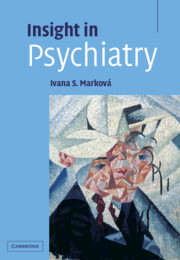Book contents
- Frontmatter
- Contents
- Dedication
- Preface
- Part I Historical and Clinical
- Part II Conceptual
- 6 The conceptualisation of insight
- 7 The relational aspects of insight: the ‘object’ of insight assessment
- 8 Towards a structure of insight: awareness and insight, an essential distinction?
- 9 Towards a structure of insight: the relationship between awareness and insight
- References
- Index
9 - Towards a structure of insight: the relationship between awareness and insight
from Part II - Conceptual
Published online by Cambridge University Press: 22 October 2009
- Frontmatter
- Contents
- Dedication
- Preface
- Part I Historical and Clinical
- Part II Conceptual
- 6 The conceptualisation of insight
- 7 The relational aspects of insight: the ‘object’ of insight assessment
- 8 Towards a structure of insight: awareness and insight, an essential distinction?
- 9 Towards a structure of insight: the relationship between awareness and insight
- References
- Index
Summary
In Chapter 8 it was argued, on theoretical and empirical grounds, that there is an essential distinction between awareness as a narrow concept and insight as a wide concept. In consequence, the corresponding phenomena of awareness and insight could be differentiated on structural (nature of the constitutive judgements involved) and clinical (contents of individuals' utterances) grounds. The question addressed in this chapter concerns the nature of the relationship between awareness and insight. In other words, whilst a conceptual distinction can be made, it is equally evident that, given the interchangeableness of terms, overlap of, and generalisations between empirical studies, awareness and insight must share much in common. The question is how can their relationship be best understood? Is it possible to formulate an overall structure for insight that can help to clarify this relationship?
This chapter proposes a basic structure of insight in which the narrow and wider meanings can be integrated. The structure helps to understand the ways in which individual insight phenomena will be determined and delineated in relation to different ‘objects’ of insight. The clinical determinants and constituents of these insight phenomena will then be discussed in the light of the overall structure. Lastly, the implications carried by the model structure of insight for understanding insight in clinical terms and for directing future research on insight are explored.
- Type
- Chapter
- Information
- Insight in Psychiatry , pp. 271 - 292Publisher: Cambridge University PressPrint publication year: 2005



